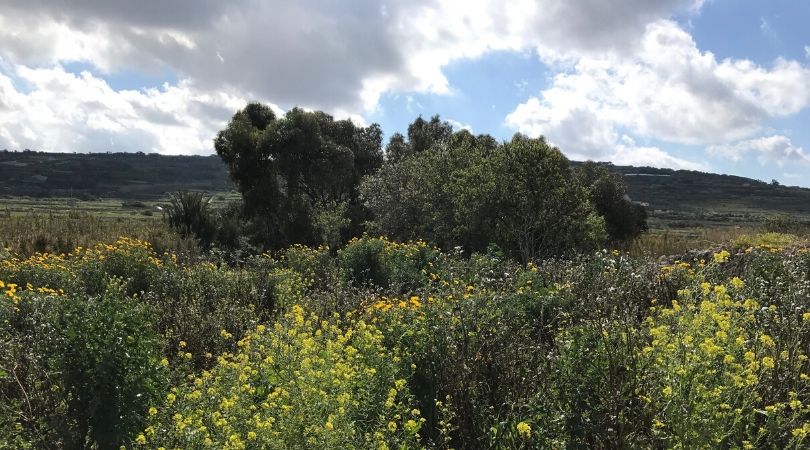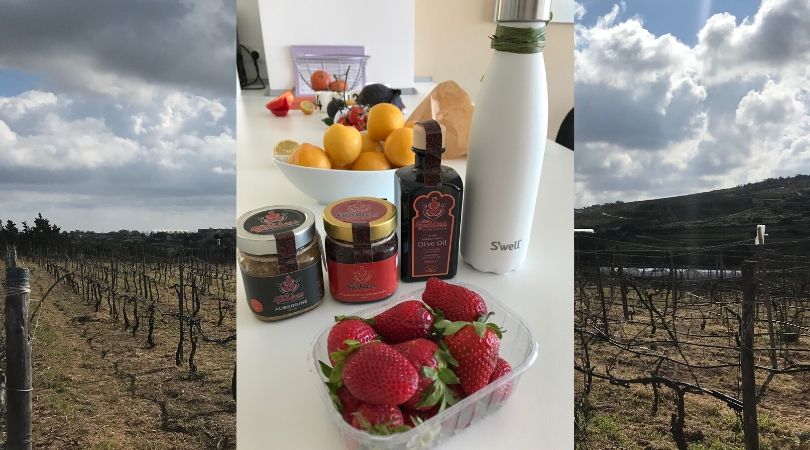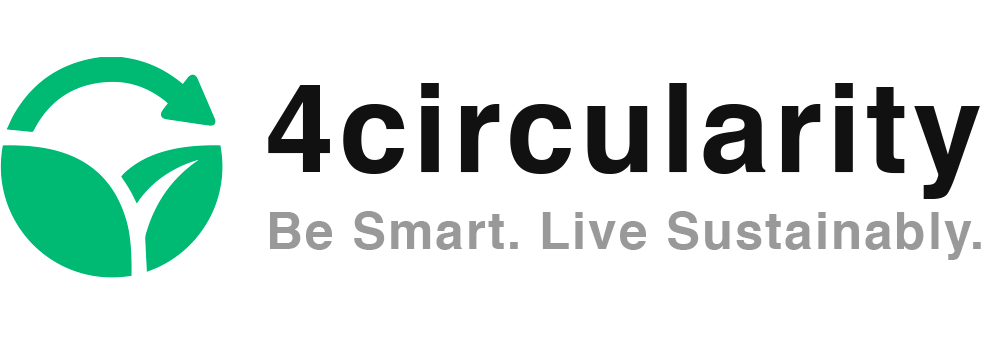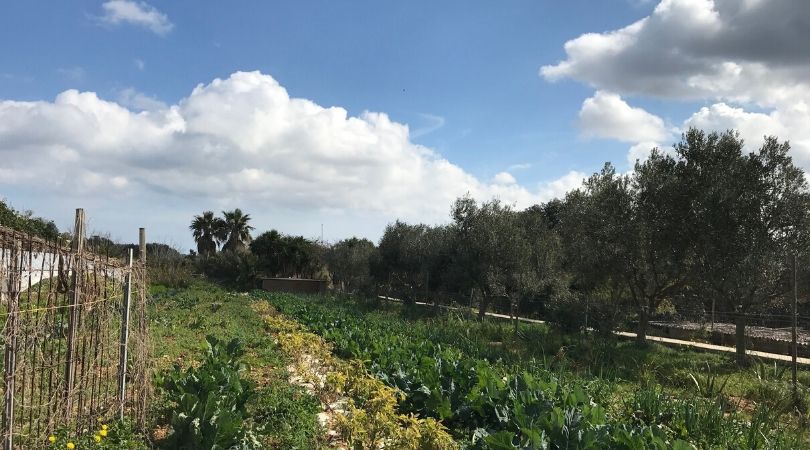Last weekend I had a chance to visit Vincent’s Eco-farm in the central region of Malta. The visit was organised by the Friends of the Earth Malta and included a guided tour by one of the farmers of the Eco-farm.
Putting ecological farming in practice in Malta is actually a little miracle itself. Currently only 13 farms practice organic farming. However, the number is slowly increasing. The three biggest challenges of organic farming in Malta are lack of rain, lack of subsidies, and drought due to extremely long, hot and dry period from March to October.
Quick facts about agriculture in EU and Malta
40% of Europe’s surface area is covered by agricultural land space. In Malta, farming counts 2% of the GDP and from the habitation only 0,03% are farmers. This is mostly due to the farmers’ high average age and the lack of young farmers, who struggle with access to land and high investment costs.
Respected agricultural policies on an Eco-farm are Common Agricultural Policy (CAP) and nitrates directives that both require a lot of paper work from the farmer. In 2021, a new budget is being prepared for CAP. The budget is 38% of the whole EU budget and the challenge to share it between European Union countries is important.
Why the CAP has been criticized, is that the polluters get payed a lot more than organic farmers. They receive subsidies for taking actions to reduce fertilizers and pesticides use and creating circular water management systems. As the organic farmers are already respecting these rules and regulations, they are not receiving subsidies. Supporting Eco-farmers by buying their products over commercial farmers’ products, has never been as important as now.
Eco-farming in challenging conditions

Organic conversion process took two years at the Vincent’s Eco-farm. There has been farming in the area for 5000 years meaning that the soil has been burnt hundreds of thousands of times for carbon concentration. The size of the farm is 12 hectares with buffer zones, consisting of planted trees. The buffer zones job is to protect the soil from drought and erosion. A cool fact is that the farm has an UNESCO protected 220-years-old olive tree!
Water conservation is one of the biggest challenges on an island where rainfall is expected only in 65 days per year. Rainwater is collected and reused in watering the plants. For watering, the farmer builds ditches forming a “zigzag” which gives the soil enough time to absorb water. When one ditch gets full it spills into the next one and so on. The origin of this ancient system is Japan. The most favorable irrigation water for lettuce and strawberries is a mix of rainwater and freshwater. It gives them the minerals they need for growing.
The second biggest challenge is soil composition. A productive soil needs carbon. At the Vincent’s Eco-farm, the farmer lets chicken to prepare the farmland before planting the crops. Cardboard is mainly used as a natural source of nitrogen. Weed is grown, then cut to decompose, forming a thicker layer of soil. In addition to these methods, a furrow system is in use because it helps with capturing carbon to the soil.
The third biggest challenge is pests and diseases control. No pesticides or fertilizers use are allowed in an Eco-farm meaning in order to control them, requires much more manual work. Snails and cabbage butterfly eggs are collected by hand every day, and then either farmed or given away. Some other pests are bush rats who come to drink from the trees in the buffer zones. The bush rats removes the bark which leaves the trees to die. The farm has ten dogs to chase the bush rats every morning and evening. A weekly catch is around 20 rats.
The fourth biggest challenge for local Eco-farmers is competition of customers with imported vegetables and fruits that are much more cheaper than organic ones. Unlike in commercial farming, in Eco-farming the soil rests after each harvest. Eco-farming runs with the terms and conditions of the nature and the produce is based on local and seasonal vegetables, fruits and herbs. Consumers are so used to find everything throughout the year. In short, our food consumption habits needs to change for climate-friendly and seasonal, supporting local, organic farmers.
Eco-farmer’s responsibilities

Vincent’s Eco-farm is fully certified organic farm. What takes the most of the farmer’s time is different reports they need to provide for the agricultural regulatory officials. Farmers need to report about the harvest, lost products and sold products. In order to keep the certification, the farm receives regular check-ups concerning traceability, transparency and samples of the soil. On top of these tasks, the farm needs to be sustainably managed.
Harvest of the day

At the end of the guided tour in the farm, we had a chance to try the organic and fresh products. The Eco-farm’s strawberries are amazingly sweet and free from all chemicals. Strawberries are the Vincent’s Eco-farm flagship product and I got to admit that they taste heavenly good.
The harvest of the day is picked up every morning before 9AM and sold in the farm’s own boutique. The selection consists of daily fresh vegetables, fruits and herbs but also local and partly imported, mostly vegan products. In the boutique you can find the Eco-farm’s honey, olive oil, jam, chutney, pasta sauce and dips as well!

For home, I bought the Eco-farm’s own brand “Red Goddess” olive oil, aubergine caviar and strawberry-lemongrass jam!
Now that I am conscious about Eco-farmers challenges with the climate, water conservation, soil composition, dealing with pests and diseases and competition with commercial farmers, it actually creates a whole new meaning for eating organically produced vegetables and fruits. I will enjoy these treats with humbleness and gratitude!
As seen above, ecological farming is not a piece of cake due to changing climate and lack of holistic understanding. Eco-farming is usually a small scale local business, where the mindset is always on quality over quantity.
Would you like to read more about sustainable, climate-friendly foods and diets? Check my recent post about four steps to a more sustainable and healthy diet.


Hi,
I am Nabil Zakraoui moroccan agricultural farmer and harvesting cultivating picking fruits and vegetables.i would like to work in Malta farm.can you help me please?
Thanks and best regards,
Nabil Zakraoui
I am Nabil zakraoui moroccan agricultural farmhand harvest labor agricultural and I have experience of working and driving license category B.i would like to work in Malta farm in anything anywhere anywork.i need an employment contract working in order to work.can you help me please?
Thanks and best regards,
Nabil zakraoui moroccan agricultural
Dear Nabil, thank you for your comment. Unfortunately I am not the right person to talk to as I don’t have direct contact with the eco farm. However you can try being direct contact with the staff at the farm. Here is the website link: https://vincentecoestate.com/